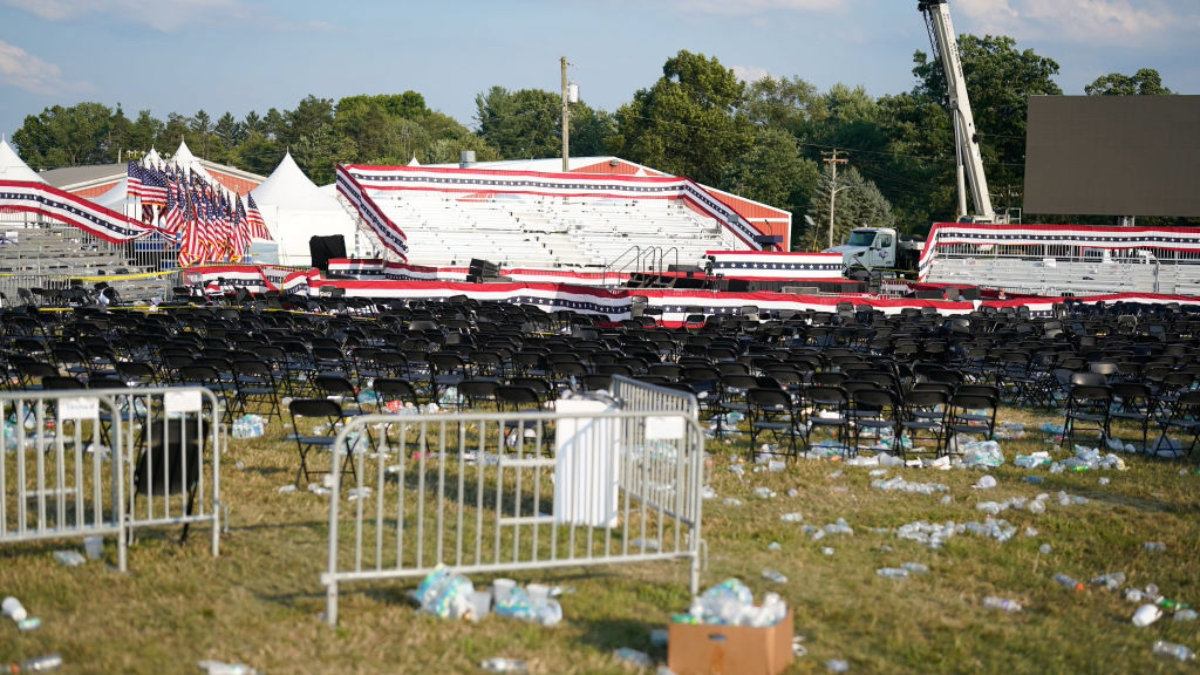Brazil Case Offers Insight on Predictable Misinformation Post-Trump Shooting
Roberta Braga, Cristina Tardáguila / Jul 16, 2024As the US deals with misinformation online following the Trump shooting, a look at a case out of Brazil can help society stay vigilant and alert, write Roberta Braga and Cristina Tardáguila from The Digital Democracy Institute of the Americas (DDIA).

BUTLER, PENNSYLVANIA - July 13: The aftermath of an assassination attempt on former President Donald Trump at a campaign rally. (Photo by Jabin Botsford/The Washington Post via Getty Images)
False claims and narratives that spread following acts of violence against political leaders are rarely completely new, ‘never-heard-before’ lies. Most often, viral misinformation underpins broader conspiracies that already exist or reflect falsehoods that have spread organically along partisan lines before. This predictable aspect of misinformation is a silver lining that can help us all get ahead of manipulative or false content online in times of crisis.
Following the July 13 assassination attempt against former President and 2024 Republican nominee Donald Trump at a campaign rally in Pennsylvania, Digital Democracy Institute of the Americas (DDIA) researchers identified false claims, narratives, and conspiracies that have been used in at least one other case of violence – the stabbing of Brazil’s then Presidential candidate Jair Bolsonaro in 2018.
The misinformation reflects a wider trend of belief that elites are “plotting” against the larger public or working with media and social media companies to “hide the truth” from us, two narratives that our recent DDIA poll found to be increasingly penetrating in the United States. The false information circulating is also reflective of a fissure of distrust between the right and left in the US and across the Americas.
At the Digital Democracy Institute of the Americas (DDIA), we bring together insights and actors across the Western Hemisphere to shape a more participatory, inclusive, and resilient digital democracy. We apply research at the intersection of information integrity, belief, and behavior to build trust, connection, and capacity with Latino communities and to shape policy interventions that bridge-build and depolarize shared information spaces for healthier democracies in the Americas.
Based on our observation of misinformation and related phenomena, we see a number of themes to consider. In particular, a look at the connections between what is being shared on social media and messaging apps in the US currently and what was seen following the Bolsonaro stabbing in 2018 can help consumers of information identify and avoid repeating misleading patterns and trends. By becoming more aware of and resilient to these patterns, we can all foster a healthier internet conducive to democratic debate.
What Should We Watch for Online?
In hyper-partisan right wing spaces, in the coming weeks, consumers of information should be cognizant of the following cases of problematic information:
- Misattributions regarding the shooter.
In the first 24 hours after the assassination attempt against Trump, posts went viral in English, Spanish, and Portuguese naming at least two seemingly unrelated individuals as culprits. While the US shooter’s identity is now known, as new information about Thomas Matthew Crooks surfaces, there will continue to be speculation regarding his potential motives, affiliations, past history, and about whether he communicated with anyone leading up to the event. Be aware also of potential fake accounts being created on social media in his name.
Six years ago, in Brazil, a namesake of Adélio Bispo (the man who stabbed Bolsonaro in the abdomen during a campaign event) was widely attacked on social media after being mistaken for the criminal.
- An increase in the number of posts using the assassination attempt as false proof of the existence of a Deep State.
This age-old conspiracy theory falsely suggests that a powerful and global elite with a left-leaning point of view is working to control and determine the future of the planet. This false narrative is already being amplified by some digital influencers, like the conspiracy theorist Alex Jones. DDIA has spotted several posts suggesting that the US Secret Service Agents who were with Trump on July 13 are part of the "Deep State" or paid by it to fail in protecting the Republican candidate.
Understanding the roots of the Deep State, or “global control,” conspiracy theory and how it gets amplified across borders can be helpful in the upcoming days. In 2018, several hyper-partisan bloggers pushed the idea that the same "Deep State" was interested in somehow delaying the investigations regarding the Bolsonaro stabbing. On social media, right-wing influencers falsely accused TV channels like Globo and journalists of being members of this imaginary powerful elite and of hiding information about the attack.
- A general blaming of and demonization of the left, with false insinuations that the US Democratic party is an enemy force that somehow plotted to have their opposition assassinated so they could win the 2024 presidential election.
False claims that Thomas Matthew Crooks, the man who shot at Donald Trump, had been affiliated with the left are spreading, as they did about Adélio Bispo in 2018. Conspiracies about one side having “sent the orders” are already being amplified by at least one sitting member of the US Congress and by digital influencers. In the US, the man responsible for the attack was a registered Republican.
In the Brazilian case, the criminal had been a registered member of a left-wing party (PSOL) between 2007 and 2014, but was no longer affiliated with it when he stabbed the then-presidential candidate. Outdated documents about Adelio's political position were shared online – especially in YouTube channels – to promote hate against leftists. In the US, some social media profiles are amplifying the fact that Crooks donated $15 to a progressive PAC in 2021 to do the same.
- Praise and glorification of the former President by the far right as an unbreakable man anointed by God to be elected the next president of the United States
This framework is likely to continue to be used on the campaign trail, both for praise and to distract from policy criticisms in the future, as they did of Bolsonaro following his 2018 stabbing. In the US, images suggesting that Trump was shot not only in the right ear but also in the chest went viral the day after the shooting, together with some language highlighting how smart he had been for accepting to wear a bullet-proof life vest. Several fact-checking units, however, have shown that the so-called bullet hole in the candidate's suit is actually a wrinkle in the suit of one of his security officers.
In Brazil, images of the right-wing candidate in clear pain were distributed with texts framing Bolsonaro as a strong and healthy military man who could withstand anything. During the days he was in the hospital and especially after the surgeries he had to go through, several images were leaked to social media showing an impressive scar on the candidate's belly. Comments on how brave he had been, followed by different types of prayers in his name became popular. In several platforms, the idea that he would be a tough president because he had survived the stabbing was also detected in 2018.
In the first 24 hours following the attack against Donald Trump, users on social media and popular messaging apps in the US also flooded the ecosystem with images, videos, and infographics showing how Trump "narrowly escaped" being killed in Pennsylvania on July 13. This type of content has garnered religious reactions. Comments about him being saved by God are already frequent and are expected to become more popular, paving the way for the idea that the Republican is predestined to be re-elected and save the country. This narrative was espoused by some speakers at the Republican National Convention this week.
In hyper-partisan left wing spaces, in the coming weeks, consumers of information should be aware of:
- Conspiracy theories claiming Former President Trump and his campaign orchestrated or staged the attacks to gain popular support.
In the US, more fringe left-leaning public Telegram channels and 4chan boards have begun falsely suggesting, in English and Spanish, that Trump had a fake blood capsule in his right-ear; that the sniper who killed the PA shooter had Crooks in his sight for several minutes but was told to stand back; and that the man who actually died in the event was just an actor.
In 2018, the far-left in Brazil also dove into videos and photos taken on the same day of the attack to "prove" that Bolsonaro's campaign had staged his stabbing. The first wave of misleading content was composed of zoomed-in frames of the stabbing moment followed by a caption that mentioned no blood had come out of Bolsonaro's body. The second movement was to distribute several pictures showing a healthy Bolsonaro walking on the hall of a hospital and talking to nurses, with no blood on his shirt. Those photos were real, but dated before the attack.
- Dark humor and memes
In the first days after Trump's attack, DDIA detected memes comparing the Republican candidate to Van Gogh, the Dutch painter who cut his own ear. In 2018, memes connecting Bolsonaro to a children's game called Pop up Pirate were common. In this game, the pirate jumps from a barrel after being stabbed several times.
In the coming weeks, narratives around the shooting will continue to evolve. Here is what we can all do to assure the facts prevail in online discussions:
1. Check your sources, and your biases
People with high levels of interest in politics on both sides of the aisle and consumers of hyper-partisan news and information are more likely to see and believe misleading information, as affirmed by a recent survey of 3,000 US-based Latinos done by DDIA. Reputable journalists will offer facts, data, and quote at least two or three sources when making assertions. Before sharing content, check that the sources you are engaging with are reliable and pay attention to your own biases. It always helps to assure what you are reading has been validated by more than 2 or 3 additional news outlets as well.
2. Watch for emotional language
Without minimizing what happened (both of these attacks were assassination attempts on political leaders), remain cautious and vigilant for headlines or posts that use sensationalist or overly emotional language or that have the clear objective of discrediting a specific side or another. These may, and often do, come from well-known names online.
3. Beware of scapegoating
Extreme narratives often aim to divide the population by scapegoating or blaming one side or the other for what happened. Per researchers at Google’s Jigsaw and Cambridge University, scapegoating “drastically simplifies a complicated issue by diverting attention somewhere else.” Partisans who scapegoat redirect attention off of themselves or their favored side, and toward another group or person.
---
Over the past decade, a confluence of factors, including false, misleading, and malign information online, have exacerbated a crisis of trust and polarization within and among democratic institutions, political leaders, the press, and the public. An increasingly polluted internet has certainly widened the tears in our social fabric. Strengthening societal resilience to information disorder online is one of the keys to preserving the health of communities and democracies. With the online ecosystem being as borderless as it is, learning from misinformation's spread in contexts similar to our own in other countries is crucial for staying ahead of manipulation online.
Authors

